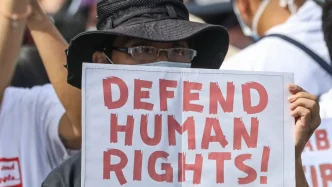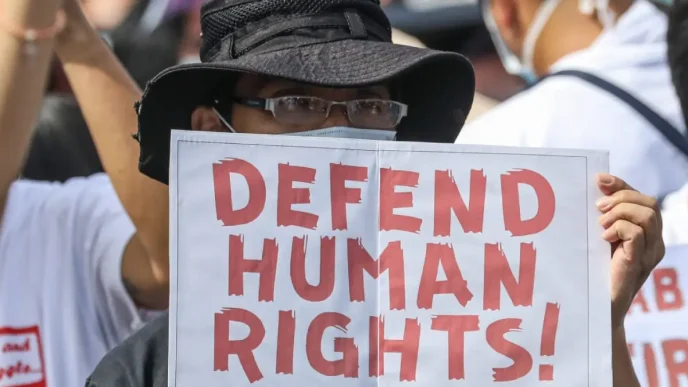In recent weeks, the tragic deaths of two young students in Indonesia have thrust the issue of school bullying into the national spotlight, exposing deep systemic failures in ensuring safe learning environments for children. The incidents, occurring in Riau and South Sulawesi, have sparked outrage among parents, educators, and activists, who are calling for urgent reforms to address the alarming rise in violence within educational institutions.
Tragic Losses Highlight a Growing Problem
On May 26, eight-year-old Khris Topel Butarbutar, a second grader at SDN 12 Buluh Rampai State Elementary School in Indragiri Hulu Regency, Riau, passed away after allegedly enduring physical abuse from older students. According to his father, Gimson Butarbutar, Khris began showing symptoms of fever and stomach pain shortly after an incident at school. “He didn’t tell me at first what was wrong, but his friends revealed he had been beaten by four older students” Gimson told local media. He later added that Khris had confided about being targeted for his religion and ethnicity over an extended period.
Despite being rushed to the hospital, Khris suffered seizures and severe internal bleeding before succumbing to his condition. An autopsy revealed bruises consistent with blunt force trauma on his stomach and thigh, though Riau Police reported the official cause of death as a systemic infection from a ruptured appendix. Authorities have yet to confirm whether the alleged assault directly contributed to the rupture, and investigations continue with 22 witnesses questioned so far. Gimson has filed a complaint against five students, aged 11 to 13, on suspicion of assault.
Less than a week later, on May 30, another tragedy unfolded in Makassar, South Sulawesi, where 15-year-old Muhammad Raja Afnan, a sixth grader at SDN Maccini Sawah State Elementary School, died following a hospital stay. His family reported visible injuries, including bruises and burn marks resembling cigarette burns, on his body. Initially, Raja claimed the injuries stemmed from a fall during a soccer game, but he later admitted to being assaulted by two peers from his school and a junior high student. The case is under investigation by Makassar police, with the family pressing for accountability.
A National Crisis in Numbers
These heartbreaking incidents are not isolated. Data from the Network for Education Watch Indonesia (JPPI) paints a grim picture, with 573 bullying cases recorded in schools and Islamic boarding schools nationwide last year—more than double the 285 cases reported the year prior. The Indonesian Child Protection Commission (KPAI) further reported that in 2024, around 21,000 children were victims of violence, a 34 percent increase from the previous year. Of these, 17 percent occurred in educational settings, with 9 percent involving peer bullying.
International comparisons underscore the severity of the issue. A 2018 survey by the Programme for International Student Assessment (PISA) found that 41 percent of Indonesian students experienced bullying at least several times a month, nearly double the average rate of 23 percent across Organisation for Economic Co-operation and Development (OECD) member countries. These figures suggest a pervasive culture of violence in schools that has gone unaddressed for far too long.
Systemic Failures and Policy Gaps
The Indonesian government has not been entirely silent on the issue. In 2023, it introduced an anti-bullying regulation mandating the establishment of Violence Prevention and Handling Teams (TPPKs) in all educational institutions. These teams are intended to safeguard students by identifying risks, intervening early, and addressing incidents of violence. However, implementation has been inconsistent at best. Many schools lack properly trained staff to recognize the subtle signs of bullying, such as social exclusion or verbal harassment, which often precede physical violence.
Education advocates argue that the regulation, while a step in the right direction, lacks the teeth needed for enforcement. “Teachers and administrators are often unaware of their responsibilities under the new rules, and there’s little accountability when they fail to act” said a spokesperson for JPPI in a recent interview with local media. Budget constraints and inadequate training programs further hinder progress, leaving many TPPKs as mere formalities rather than effective tools for change.
Moreover, cultural factors may exacerbate the problem. In some communities, hierarchical dynamics among students are seen as a natural part of growing up, with younger children expected to defer to their seniors. This mindset can normalize bullying behaviors, making it harder for victims to speak out or for adults to intervene. Addressing these attitudes requires not just policy but a broader societal shift, supported by awareness campaigns and education on empathy and conflict resolution.
The Human Cost of Inaction
Beyond the statistics and policy debates lies the profound human toll of bullying. For families like those of Khris and Raja, the loss of a child is an unimaginable pain compounded by the knowledge that it might have been preventable. Gimson Butarbutar’s account of his son’s suffering—initially hidden out of fear or shame—reflects a common barrier to addressing bullying: victims often remain silent, either due to stigma or distrust in the system’s ability to protect them.
Psychologists warn that the impact of bullying extends far beyond physical injuries. Survivors often face long-term emotional and mental health challenges, including anxiety, depression, and diminished self-esteem. For every high-profile case that reaches the headlines, countless others go unreported, leaving children to suffer in silence. “Bullying isn’t just a schoolyard issue; it’s a public health crisis” noted a child welfare expert based in Jakarta, emphasizing the need for comprehensive support systems for both victims and perpetrators, many of whom may themselves be acting out due to trauma or neglect.
Calls for Reform and Accountability
The recent deaths have galvanized public demand for stronger action. Parents’ groups and child rights organizations are urging the government to prioritize school safety by allocating more resources to teacher training, counseling services, and monitoring mechanisms. Some propose integrating anti-bullying education into the national curriculum, teaching students from a young age about respect, diversity, and non-violent conflict resolution.
At the local level, there are calls for greater community involvement. Schools could partner with parents and local leaders to create safe spaces where children feel empowered to report abuse without fear of retaliation. Meanwhile, law enforcement agencies face pressure to handle bullying cases with the seriousness they deserve, ensuring thorough investigations and appropriate consequences, even when the perpetrators are minors.
Legal experts caution, however, that any response must balance accountability with rehabilitation. “These are children, often influenced by their environments. Punishing them without addressing root causes won’t solve the problem” said a legal analyst familiar with juvenile justice in Indonesia. Programs focused on restorative justice—bringing together victims, offenders, and families to heal and learn—could offer a path forward, though such initiatives remain rare in the country.
Looking Ahead: A Test for Indonesia’s Education System
As Indonesia mourns the loss of young lives to school violence, the nation faces a critical juncture. The government’s ability to translate policy into meaningful change will be tested in the coming months, with activists warning that further inaction could erode public trust in the education system. For now, the stories of Khris and Raja serve as a stark reminder of what’s at stake—children’s safety, dignity, and right to learn without fear.
While investigations into these specific cases continue, broader questions loom about how Indonesia can foster a culture of care within its schools. Will the outrage of today lead to lasting reform, or will it fade until the next tragedy captures the headlines? The answer remains uncertain, but the urgency could not be clearer.
















